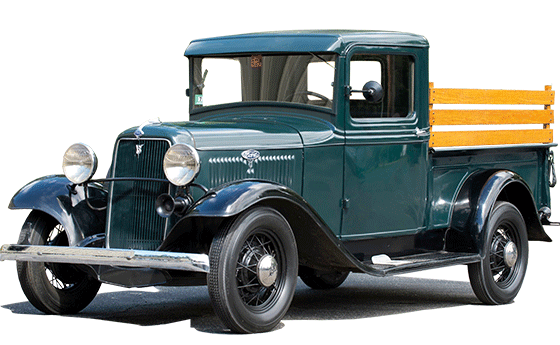One of the most popular collectible cars every produced
Although Ford had been producing factory made pickup trucks since 1925, the changes made to the truck line in 1932 would set Ford apart from its competition and establish the auto maker’s reputation as a builder of powerful and sturdy work vehicles.
The most significant change in the 1932 truck line occurred under the hood. Facing competition in the pickup truck market from the Chevrolet 6-cylinder engine, Ford decided to take a gamble, and offered their newly designed Ford Flathead V8, originally slated as an option for passenger cars, in their truck line. The decision would prove to be a popular one with the buying public. The 4-cylinder engine was still offered as an economy option, but would eventually be phased out due to low demand.
Unlike the Ford passenger cars of the era, the trucks of the 1930’s would not receive many radical styling changes. Spartan interiors and a design that focused on functionality over style would be the standard for a line that would see only minor changes for the next few years.
The next noteworthy change in appearance occurred in 1935. Styling changes for both the passenger car and truck line found favor with potential buyers, increasing sales for Ford. The trucks borrowed some design cues from their passenger car cousins and featured a slanted-back grille and windshield, tapered headlight housings, and curvaceous, skirted fenders.
In 1937, in an effort to reintroduce an economy engine, Ford offered a downsized Flathead V8, down to 136 cubic inches from the standard 221 cubic inches, as an option.
The 1938 pickup included a new updated cab and bed, a large oval grille, and generously rounded front and rear fenders.
As the decade closed, Ford, coerced by competition and public pressure, introduced hydraulic brakes for the first time in 1939.
With the arrival of the 1940’s, Ford pickup trucks and passenger cars shared styling traits closer than ever before. In 1940, the pickup truck carried such passenger car cues as a vee-shaped grille and fenders with integral headlights. Interiors were also upgraded, sharing many car features such as two-tone materials, chrome accents, and a dashboard that was more modern and less utilitarian.
Once again, in 1941, Ford offered an economy engine, this time a 6-cylinder, as an option and continued to offer the Ford Flathead V8. Providing more torque than the Flathead, the 6-cylinder engine also offered better fuel economy. In the same year, Ford began production of a universal “Jeep” vehicle for the military.
By 1942, Ford had made a departure from sharing passenger car styling with the truck line but shortly after the new models were introduced, the US entered WWII. The production of civilian vehicles was halted, allowing Ford to retool and concentrate on building a variety of military vehicles, including aircraft engines and bombers.
When the production of civilian vehicles resumed in 1946 and into 1947, the design of the pickup remained virtually unchanged from 1942.
The death of Ford Motor Company’s founder, Henry Ford, in 1947, brought the end of an era. Under the guidance of his grandson, Henry Ford II, a new direction for Ford trucks would take place, beginning in 1948 with the introduction of the standard setting F-Series.







